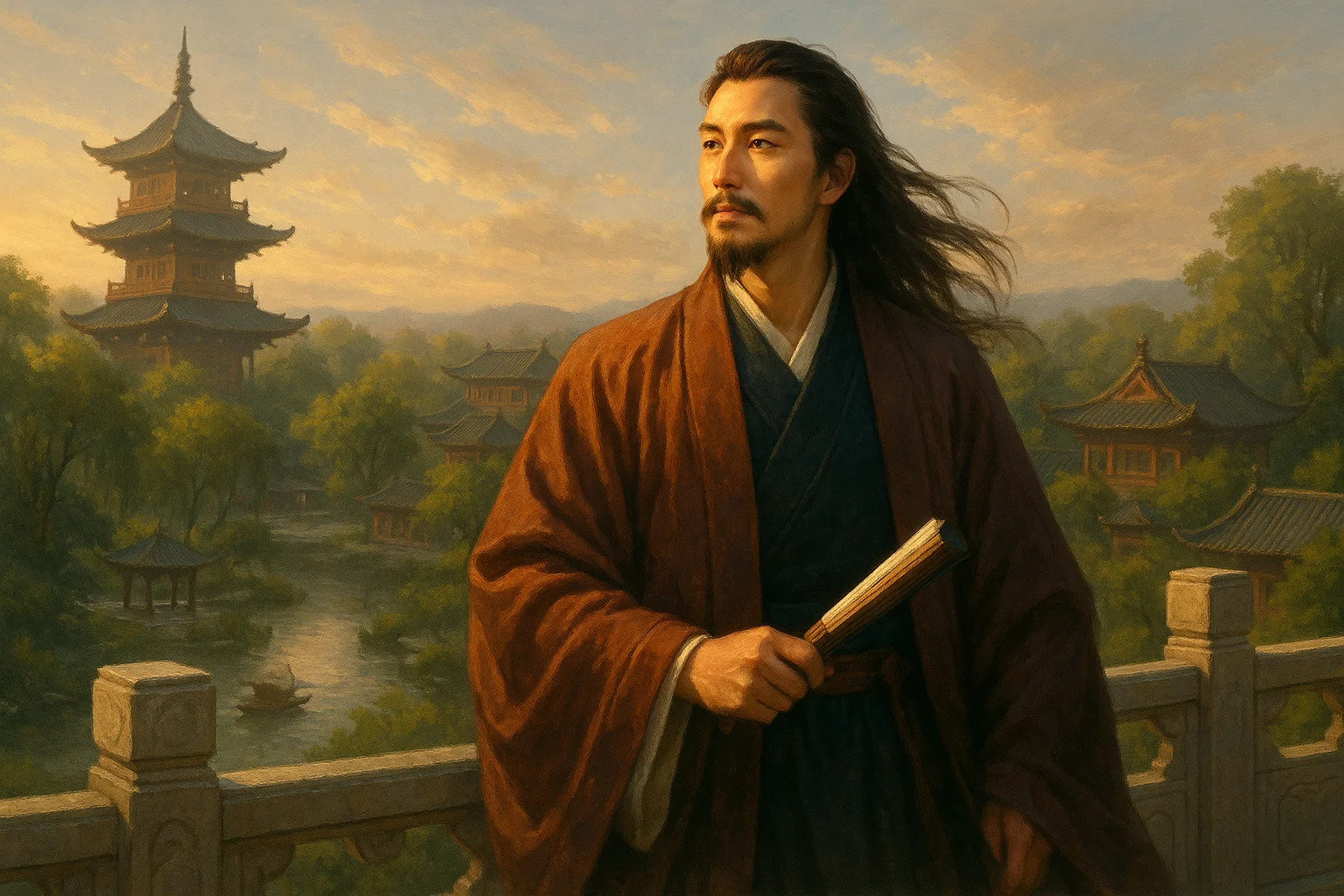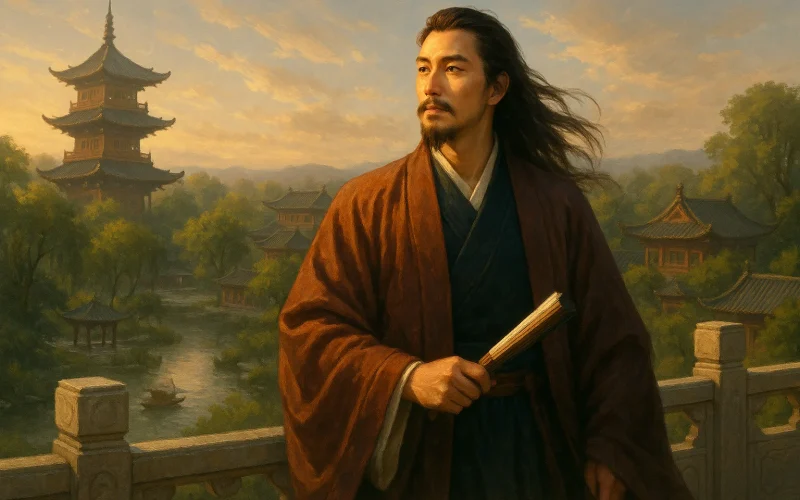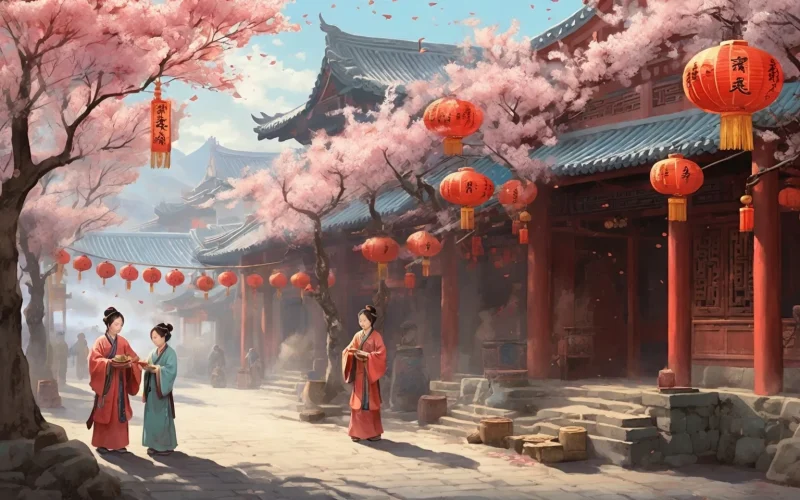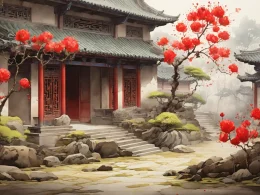On this peak that flew stands a tower so tall,
They say roosters here hatch dawn for all.
Floating clouds can't blind my eyes—
Truth's view owns the ultimate skies.
Original Poem
「登飞来峰」
王安石
飞来山上千寻塔,闻说鸡鸣见日升。
不畏浮云遮望眼,自缘身在最高层。
Interpretation
Composed during the Jiayou era of Emperor Renzong's reign in the Northern Song Dynasty, this poem was written by Wang Anshi when his reformist ideals were maturing, though his New Policies had not yet been formally implemented. Written during his ascent of Hangzhou's Feilai Peak, the poem uses the vista from a lofty pagoda to express his ambitious political vision and fearless determination to overcome obstacles. The "floating clouds" serve as metaphors for petty men and worldly prejudices, while the elevated perspective symbolizes the poet's transcendent clarity of vision. The work combines profound meaning with majestic momentum.
First Couplet: "飞来山上千寻塔,闻说鸡鸣见日升。"
Fēilái shān shàng qiān xún tǎ, wén shuō jī míng jiàn rì shēng.
On Feilai Peak stands a pagoda of thousand-fathom height; / They say at cockcrow here one sees the sunrise light.
The opening emphasizes the peak's extraordinary elevation through the "thousand-fathom pagoda" (千寻塔), which represents both the physical structure and the loftiness of ideals. The reference to hearing roosters and seeing sunrise at the summit alludes to the mystical text Xuánzhōng Jì, suggesting that only from great heights can one witness dawn's first light - metaphorically implying the poet's desire to dispel darkness and usher in new enlightenment, thus foreshadowing the poem's central theme.
Second Couplet: "不畏浮云遮望眼,自缘身在最高层。"
Bú wèi fúyún zhē wàng yǎn, zì yuán shēn zài zuì gāo céng.
Fear not the floating clouds that obscure the view; / For you stand at the summit's topmost cue.
These lines constitute the poem's conceptual pinnacle and most frequently quoted passage. The "floating clouds" (浮云) symbolize obstructive forces like petty men, rumors, and prejudices that cloud vision. The "summit's topmost level" (最高层) represents not just physical altitude but the height of political ideals, moral character, and comprehensive insight. The tone combines unshakable confidence with rational conviction, blending soaring spirit with profound reflection, ultimately showcasing Wang Anshi's reformist zeal and his indomitable spirit against conventional mediocrity.
Holistic Appreciation
This is a seven-character quatrain with lofty aspirations and majestic momentum. While ostensibly depicting the act of ascending a tower to gaze afar, it is in fact a metaphorical expression of ambition and vision—using scenery to convey philosophy, and the tower to articulate sentiments. Through the towering height of the ancient "Thousand-Fathom Pagoda", the poet evokes a political pursuit that transcends practical limitations and societal prejudices. The middle couplet employs subtle and ingenious allusions, while the concluding line—"standing at the highest level"—embodies both intellectual elevation and unshaken confidence. Comprising four lines of seven characters each, the poem progresses layer by layer with rigorous structure and profound intent. It serves not only as Wang Anshi's political manifesto but also as a philosophical guide for later generations to contemplate life and perceive the world clearly.
Artistic Merits
- Scenery as Ambition, Boundless Conception
By describing the act of climbing a high tower, the poet expresses political aspirations and philosophical reflections, exemplifying the artistic style of "using scenery to convey principles, and events to reveal ambition." - Exquisite Allusions, Natural Transformation
"At cockcrow, behold the rising sun" draws from the mythological allusions in "Records of the Mysterious Middle", but Wang Anshi transforms the abstract into the concrete and the distant into the immediate, enhancing the poem's symbolic depth and literary richness. - Concise Language, Rigorous Structure
The four-line quatrain advances progressively—from the "realistic depiction" of Feilai Peak's height to the "abstract portrayal" of clouds obscuring vision, culminating in the revelation of spiritual elevation. It stands as a model of transitioning from scenery to philosophy, and from objects to ideals. - Philosophical Depth, Far-Reaching Implications
"Floating clouds" symbolize life's distractions, while "the highest level" represents intellectual height. Their juxtaposition embodies an attitude of "fearing no heights, standing firm in independence"—a distilled expression of the poet's lifelong aspirations.
Insights
Life inevitably presents "floating clouds" that obscure our vision—be they rumors, vulgar opinions, or obstacles posed by petty individuals. Yet, by standing on high ground with steadfast vision, we can perceive the bigger picture and rise above the noise. This poem is not only a reflection of Wang Anshi's reformist spirit but has also been adopted as a motto by later generations, reminding us to maintain intellectual independence and far-sighted discernment—to be individuals who see through illusions and behold the true sunrise.
About the Poet

Wang Anshi (王安石 1021 - 1086), a native of Linchuan in Jiangxi, was an outstanding statesman, writer, and thinker of the Northern Song Dynasty, counted among the "Eight Great Prose Masters of the Tang and Song Dynasties." His poetic achievements were particularly profound—his early works, filled with heroic language, revealed the ambition of a reformer. Though his ci poetry was few in number, it pioneered new realms of historical reflection. His poetry and prose combined intellectual depth with artistic value, and the over 1,500 works preserved in The Collected Works of Linchuan stand as a monumental testament to literary innovation in Song Dynasty literature.












